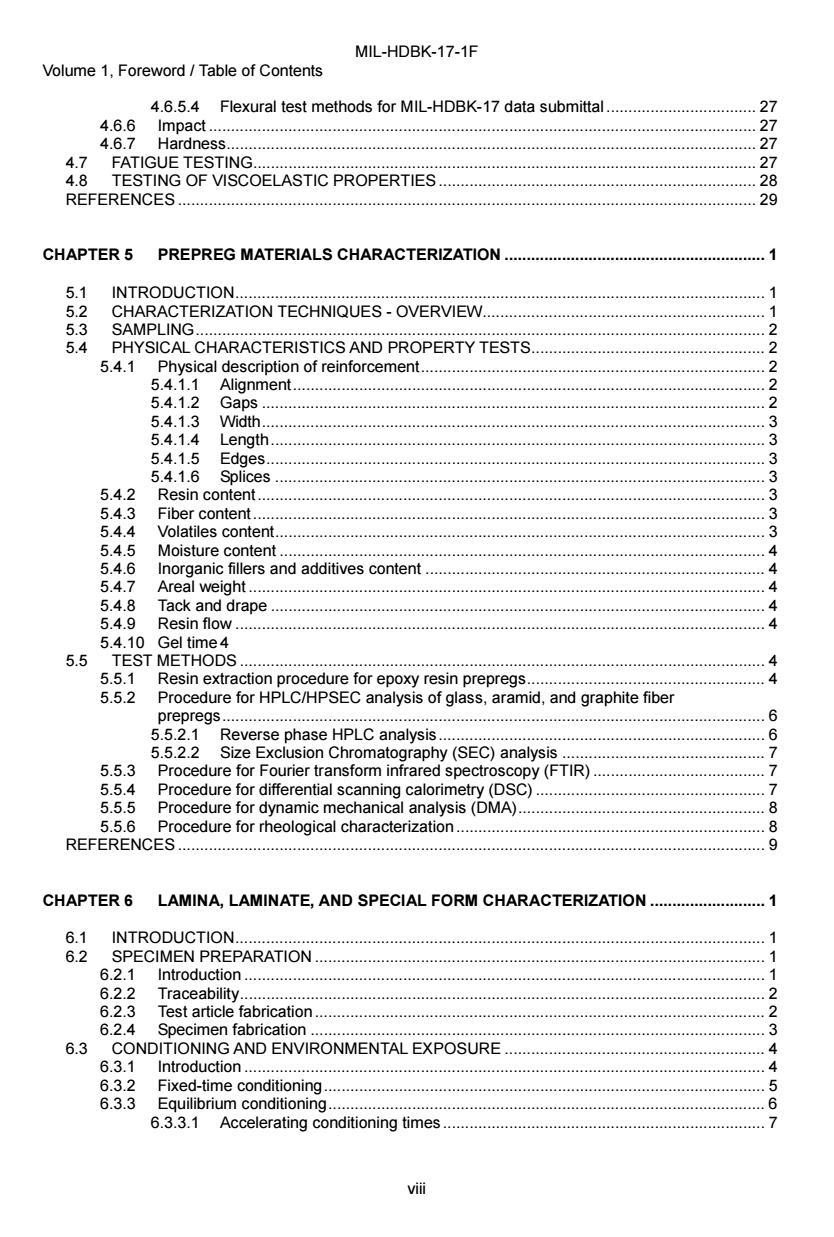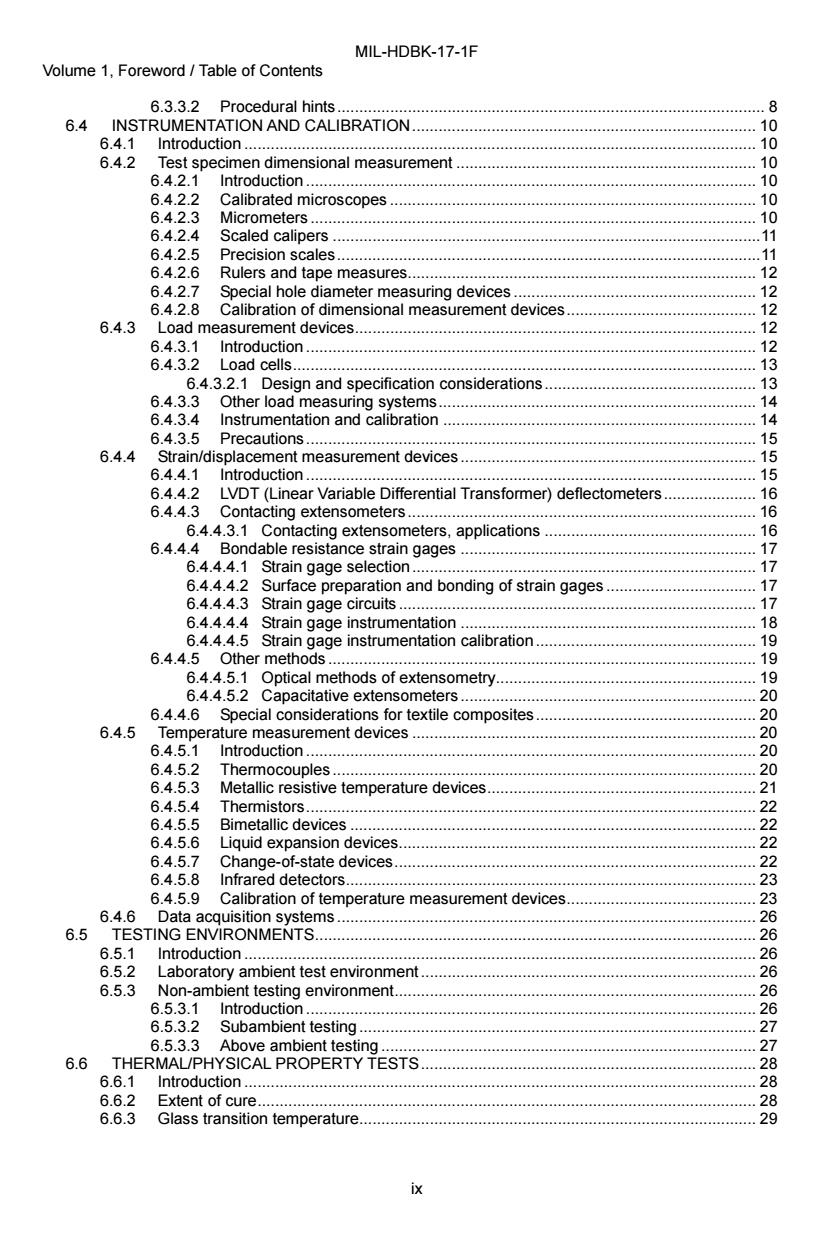
MIL-HDBK-17-1F Volume 1,Foreword Table of Contents 4.6.5.4 Flexural test methods for MIL-HDBK-17 data submittal............................27 4.6.6 27 mD泊C.444a444 4.6.7 Hardness..... 27 4.7 FATIGUE TESTING...... 27 4.8 TESTING OF VISCOELASTIC PROPERTIES 28 REFERENCES............. 29 CHAPTER 5 PREPREG MATERIALS CHARACTERIZATION............. 01 5.1 INTRODUCTION.... .1 5.2 CHARACTERIZATION TECHNIQUES-OVERVIEW... 1 5.3 SAMPLING... 2 5.4 PHYSICAL CHARACTERISTICS AND PROPERTY TESTS. 5.4.1 Physical description of reinforcement. 2 5.4.1.1 Alignment. 2 5.4.1.2 GapS.… 5.4.1.3 Width..... 3 5.4.1.4 Length.... 3 5.4.1.5 Edges.… 3 5.4.1.6 Splices 3 5.4.2 Resin content..… 3 5.4.3 Fiber content.… 5.4.4 Volatiles content… 3 5.4.5 Moisture content... 4 5.4.6 Inorganic fillers and additives content 4 5.4.7 Areal weight....... 5.4.8 Tack and drape 4 5.4.9 Resin flow.... 4 5.4.10 Gel time4 5.5 TEST METHODS 4 5.5.1 Resin extraction procedure for epoxy resin prepregs........... 4 5.5.2 Procedure for HPLC/HPSEC analysis of glass,aramid,and graphite fiber prepregs.… .6 5.5.2.1 Reverse phase HPLC analysis...................6 5.5.2.2 Size Exclusion Chromatography (SEC)analysis.... .7 5.5.3 Procedure for Fourier transform infrared spectroscopy(FTIR) .7 5.5.4 Procedure for differential scanning calorimetry (DSC)..........................7. 5.5.5 Procedure for dynamic mechanical analysis (DMA)......... 8 5.5.6 Procedure for rheological characterization................................... 8 REFERENCES .9 CHAPTER 6 LAMINA,LAMINATE,AND SPECIAL FORM CHARACTERIZATION.........................1 6.1 INTRODUCTION..... 6.2 SPECIMEN PREPARATION 1 .1 6.2.1 Introduction. 6.2.2 1 Traceability 2 6.2.3 Test article fabrication................ 2 6.2.4 Specimen fabrication .. 3 6.3 CONDITIONING AND ENVIRONMENTAL EXPOSURE 4 6.3.1 Introduction...... 4 6.3.2 Fixed-time conditioning. .5 6.3.3 Equilibrium conditioning...6 6.3.3.1 Accelerating conditioning times............. .7 viii
MIL-HDBK-17-1F Volume 1, Foreword / Table of Contents viii 4.6.5.4 Flexural test methods for MIL-HDBK-17 data submittal .................................. 27 4.6.6 Impact ............................................................................................................................ 27 4.6.7 Hardness........................................................................................................................ 27 4.7 FATIGUE TESTING.................................................................................................................. 27 4.8 TESTING OF VISCOELASTIC PROPERTIES ........................................................................ 28 REFERENCES ................................................................................................................................... 29 CHAPTER 5 PREPREG MATERIALS CHARACTERIZATION ........................................................... 1 5.1 INTRODUCTION........................................................................................................................ 1 5.2 CHARACTERIZATION TECHNIQUES - OVERVIEW................................................................ 1 5.3 SAMPLING................................................................................................................................. 2 5.4 PHYSICAL CHARACTERISTICS AND PROPERTY TESTS..................................................... 2 5.4.1 Physical description of reinforcement.............................................................................. 2 5.4.1.1 Alignment........................................................................................................... 2 5.4.1.2 Gaps .................................................................................................................. 2 5.4.1.3 Width.................................................................................................................. 3 5.4.1.4 Length................................................................................................................ 3 5.4.1.5 Edges................................................................................................................. 3 5.4.1.6 Splices ............................................................................................................... 3 5.4.2 Resin content................................................................................................................... 3 5.4.3 Fiber content.................................................................................................................... 3 5.4.4 Volatiles content............................................................................................................... 3 5.4.5 Moisture content .............................................................................................................. 4 5.4.6 Inorganic fillers and additives content ............................................................................. 4 5.4.7 Areal weight ..................................................................................................................... 4 5.4.8 Tack and drape ................................................................................................................ 4 5.4.9 Resin flow ........................................................................................................................ 4 5.4.10 Gel time 4 5.5 TEST METHODS ....................................................................................................................... 4 5.5.1 Resin extraction procedure for epoxy resin prepregs...................................................... 4 5.5.2 Procedure for HPLC/HPSEC analysis of glass, aramid, and graphite fiber prepregs........................................................................................................................... 6 5.5.2.1 Reverse phase HPLC analysis.......................................................................... 6 5.5.2.2 Size Exclusion Chromatography (SEC) analysis .............................................. 7 5.5.3 Procedure for Fourier transform infrared spectroscopy (FTIR) ....................................... 7 5.5.4 Procedure for differential scanning calorimetry (DSC) .................................................... 7 5.5.5 Procedure for dynamic mechanical analysis (DMA)........................................................ 8 5.5.6 Procedure for rheological characterization...................................................................... 8 REFERENCES ..................................................................................................................................... 9 CHAPTER 6 LAMINA, LAMINATE, AND SPECIAL FORM CHARACTERIZATION .......................... 1 6.1 INTRODUCTION........................................................................................................................ 1 6.2 SPECIMEN PREPARATION ...................................................................................................... 1 6.2.1 Introduction ...................................................................................................................... 1 6.2.2 Traceability....................................................................................................................... 2 6.2.3 Test article fabrication ...................................................................................................... 2 6.2.4 Specimen fabrication ....................................................................................................... 3 6.3 CONDITIONING AND ENVIRONMENTAL EXPOSURE ........................................................... 4 6.3.1 Introduction ...................................................................................................................... 4 6.3.2 Fixed-time conditioning.................................................................................................... 5 6.3.3 Equilibrium conditioning................................................................................................... 6 6.3.3.1 Accelerating conditioning times......................................................................... 7

MIL-HDBK-17-1F Volume 1,Foreword Table of Contents 6.3.3.2 Procedural hints....... .8 6.4 INSTRUMENTATION AND CALIBRATION.............. 10 6.4.1 Introduction.. 10 6.4.2 Test specimen dimensional measurement............ 10 6.4.2.1 Introduction.10 6.4.2.2 Calibrated microscopes............. 10 6.4.2.3 Micrometers. 10 6.4.2.4 Scaled calipers.....................1 6.4.2.5 PreciSion Scales.. 6.4.2.6 Rulers and tape measures..... 12 6.4.2.7 Special hole diameter measuring devices..................12 6.4.2.8 Calibration of dimensional measurement devices.......... 12 6.4.3 Load measurement devices......................... 12 6.4.3.1 Introduction.. 12 6.4.3.2 2 Load cells..... 13 6.4.3.2.1 Design and specification considerations........................13 6.4.3.3 Other load measuring systems..... .14 6.4.3.4 Instrumentation and calibration ..14 6.4.3.5 Precautions… 15 6.4.4 Strain/displacement measurement devices...................................15 6.4.4.1 Introduction. 4444444444 .15 6.4.4.2 LVDT(Linear Variable Differential Transformer)deflectometers..... 16 6.4.4.3 Contacting extensometers................. 16 6.4.4.3.1 Contacting extensometers,applications...... 16 6.4.4.4 Bondable resistance strain gages 17 6.4.4.4.1 Strain gage selection..... .17 6.4.4.4.2 Surface preparation and bonding of strain gages................................1.7 6.4.4.4.3 Strain gage circuits.17 6.4.4.4.4 Strain gage instrumentation.... 18 6.4.4.4.5 Strain gage instrumentation calibration....... 19 6.4.4.5 Other methods..... 19 6.4.4.5.1 Optical methods of extensometry............................. 19 6.4.4.5.2 Capacitative extensometers........ 20 6.4.4.6 Special considerations for textile composites.................................... 20 6.4.5 Temperature measurement devices. 20 6.4.5.1 htroducton............................................................................. 20 6.4.5.2 Thermocouples.................... 20 6.4.5.3 Metallic resistive temperature devices... 21 6.4.5.4 Thermistors....... 22 6.4.5.5 Bimetallic devices..... 22 6.4.5.6 Liquid expansion devices............ 22 6.4.5.7 Change-of-state devices. 22 6.4.5.8 Infrared detectors................ 23 6.4.5.9 Calibration of temperature measurement devices........................................... 23 6.4.6 Data acquisition systems..... 26 6.5 TESTING ENVIRONMENTS................. 26 6.5.1 Introduction..… 26 6.5.2 Laboratory ambient test environment..... 26 6.5.3 Non-ambient testing environment............ 26 6.5.3.1 Introduction...... 26 6.5.3.2 Subambient testing.… 27 6.5.3.3 Above ambient testing.. 27 6.6 THERMAL/PHYSICAL PROPERTY TESTS 444444444444444 28 6.6.1 Introduction .... 28 6.6.2 Extent of cure............ 28 6.6.3 Glass transition temperature.............. .29
MIL-HDBK-17-1F Volume 1, Foreword / Table of Contents ix 6.3.3.2 Procedural hints................................................................................................. 8 6.4 INSTRUMENTATION AND CALIBRATION.............................................................................. 10 6.4.1 Introduction .................................................................................................................... 10 6.4.2 Test specimen dimensional measurement .................................................................... 10 6.4.2.1 Introduction ...................................................................................................... 10 6.4.2.2 Calibrated microscopes ................................................................................... 10 6.4.2.3 Micrometers..................................................................................................... 10 6.4.2.4 Scaled calipers .................................................................................................11 6.4.2.5 Precision scales................................................................................................11 6.4.2.6 Rulers and tape measures............................................................................... 12 6.4.2.7 Special hole diameter measuring devices ....................................................... 12 6.4.2.8 Calibration of dimensional measurement devices........................................... 12 6.4.3 Load measurement devices........................................................................................... 12 6.4.3.1 Introduction ...................................................................................................... 12 6.4.3.2 Load cells......................................................................................................... 13 6.4.3.2.1 Design and specification considerations................................................ 13 6.4.3.3 Other load measuring systems........................................................................ 14 6.4.3.4 Instrumentation and calibration ....................................................................... 14 6.4.3.5 Precautions...................................................................................................... 15 6.4.4 Strain/displacement measurement devices................................................................... 15 6.4.4.1 Introduction ...................................................................................................... 15 6.4.4.2 LVDT (Linear Variable Differential Transformer) deflectometers..................... 16 6.4.4.3 Contacting extensometers............................................................................... 16 6.4.4.3.1 Contacting extensometers, applications ................................................ 16 6.4.4.4 Bondable resistance strain gages ................................................................... 17 6.4.4.4.1 Strain gage selection.............................................................................. 17 6.4.4.4.2 Surface preparation and bonding of strain gages .................................. 17 6.4.4.4.3 Strain gage circuits................................................................................. 17 6.4.4.4.4 Strain gage instrumentation ................................................................... 18 6.4.4.4.5 Strain gage instrumentation calibration.................................................. 19 6.4.4.5 Other methods................................................................................................. 19 6.4.4.5.1 Optical methods of extensometry........................................................... 19 6.4.4.5.2 Capacitative extensometers................................................................... 20 6.4.4.6 Special considerations for textile composites.................................................. 20 6.4.5 Temperature measurement devices .............................................................................. 20 6.4.5.1 Introduction ...................................................................................................... 20 6.4.5.2 Thermocouples................................................................................................ 20 6.4.5.3 Metallic resistive temperature devices............................................................. 21 6.4.5.4 Thermistors...................................................................................................... 22 6.4.5.5 Bimetallic devices ............................................................................................ 22 6.4.5.6 Liquid expansion devices................................................................................. 22 6.4.5.7 Change-of-state devices.................................................................................. 22 6.4.5.8 Infrared detectors............................................................................................. 23 6.4.5.9 Calibration of temperature measurement devices........................................... 23 6.4.6 Data acquisition systems............................................................................................... 26 6.5 TESTING ENVIRONMENTS.................................................................................................... 26 6.5.1 Introduction .................................................................................................................... 26 6.5.2 Laboratory ambient test environment ............................................................................ 26 6.5.3 Non-ambient testing environment.................................................................................. 26 6.5.3.1 Introduction ...................................................................................................... 26 6.5.3.2 Subambient testing.......................................................................................... 27 6.5.3.3 Above ambient testing ..................................................................................... 27 6.6 THERMAL/PHYSICAL PROPERTY TESTS............................................................................ 28 6.6.1 Introduction .................................................................................................................... 28 6.6.2 Extent of cure................................................................................................................. 28 6.6.3 Glass transition temperature.......................................................................................... 29